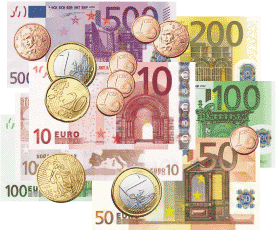
Europe's Move Toward One Currency
Starting on January 1, 2002, most Europeans exchanged their change and paper money for a different kind of coins and banknotes. They took their French francs, German marks, Dutch guilders, and other national currencies to the bank and traded them in for euros.
What Is a Euro?
The euro is the new currency that many countries that are part of the European Union now use. To see a map showing the first of these euro-using countries and their two-euro coin designs, click here). The symbol for the euro is "€" and its abbreviation is "eur."
Like the American dollar, the euro comes in the form of coins and banknotes (paper money). The coins are made in eight denominations: 1, 2, 5, 10, 20, and 50 euro cents, plus 1 euro and 2 euros. Banknotes—or "euro bills"—come in seven denominations.

Two Sides to This Story
Euro banknotes in all countries look the same, front and back. But euro coins have different designs on the backs, depending on which country made each one. It's kind of like the quarters in the 50 State Quarters® Program: the fronts are all the same, but each state uses its own design on the back, yet all the quarters can be spent in all the states.
In the box to the right, you can see the 1-euro designs of the first of the major countries that took part in this modern monetary milestone. Three smaller countries also used euros, but made fewer of them because of the countries' small size, and one country (Andorra) didn't make any, but used only the euros of other nations.
50 Billion Coins!
50 billion coins and 14.25 billion banknotes were put into circulation to get the euro going. The total value of the new currency that was distributed was about 592 billion dollars!

Every coin shows the 12 stars from the flag of the European Union. The stars do not stand for 12 nations the way the stars on the American flag stand for states. The number 12 was chosen simply because it stands for completeness and has been important in world history—12 tribes of Israel, 12 apostles of Jesus, 12 labors of Hercules, 12 months in a year, and so on. The circle stands for the unity of the nations in the Union.
Why Change?
The European Union realized that buying and selling would be much easier if there were one European currency. In the old days, when traveling was much harder, it was natural for each country to have its own money. But as Europeans visited each other's countries more and more often, using different national currencies made buying and selling rather hard.
What was it like? Well, imagine if each state in the United States had a different currency. You'd have to have coins for Maryland, coins for Idaho, coins for New York...and every time you went to another state, even if it was just a few miles away, you'd have to go to the bank and exchange your money. Think what a jumble of "foreign" coins you'd collect in your coin jar! Imagine how much it would cost you, too, since banks charge for exchanging currencies.
What if you also wanted to sell things in different states? A Maryland dollar might not have the same value as a Delaware dollar, so you'd have to charge different prices in each state. Things would get pretty complicated. And if you worked in Kansas City, Kansas, but lived in Kansas City, Missouri, you'd be paid in money you couldn't use in your home state.
But Not for Everybody
At first, not all of the countries in the European Union switched to the euro. Countries like Great Britain, Sweden, and Denmark liked having their own national currencies enough to keep using them after their neighbors switched.
But you never know...someday the others may change their minds—as well as their change.
To see the most up-to-date list of countries that are members of the European Union, you can visit the Web site of the European Union in the US.
Adventure for Everybody
See the euro in action! Join in the "Coins of the World" cartoon adventure and visit France!
Return to Coins and Medals
